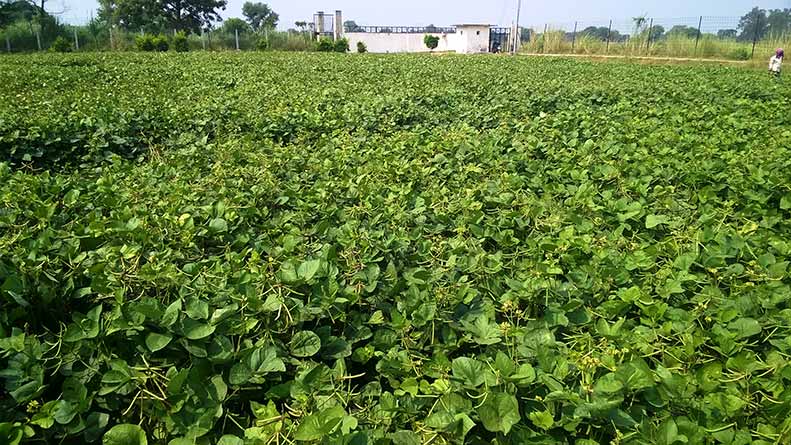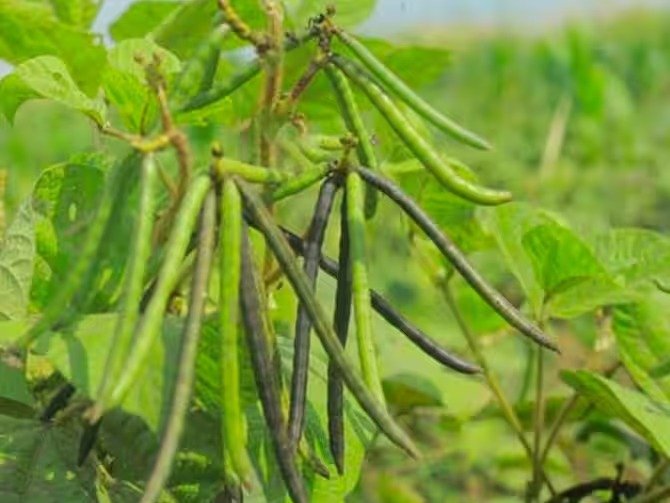Cotton farming has been a cornerstone of agriculture for centuries, providing raw materials for one ...
Mung dal, also known as green gram, is a highly nutritious legume that is widely cultivated across Asia. It is rich in protein and essential nutrients, making it a staple in many diets. Green gram is valued for its ability to improve soil fertility due to its nitrogen-fixing properties. This guide covers all the essential aspects of mung dal cultivation.
मूँग दाल, जिसे हरी मूँग भी कहा जाता है, एक अत्यंत पोषक तत्वों से भरपूर दाल है जो भारत में बड़े पैमाने पर उगाई जाती है। यह प्रोटीन, विटामिन और खनिजों का अच्छा स्रोत है और इसे विभिन्न व्यंजनों में प्रयोग किया जाता है। मूँग दाल की खेती से किसान को अच्छा लाभ होता है और यह मिट्टी की उर्वरता को भी सुधारती है। इस लेख में हम मूँग दाल की खेती से संबंधित सभी महत्वपूर्ण पहलुओं पर चर्चा करेंगे...
मूँग दाल की कई किस्में होती हैं, जो अलग-अलग जलवायु और मिट्टी की परिस्थितियों के अनुसार उगाई जाती हैं। कुछ प्रमुख किस्में हैं:
1. पूसा विमल
2. पूसा हरित
3. CO 6
इन किस्मों का चयन स्थानीय जलवायु और मिट्टी की विशेषताओं के आधार पर किया जाना चाहिए।

मूँग दाल की खेती के लिए उपजाऊ, अच्छी जल निकासी वाली मिट्टी सबसे उपयुक्त होती है। मिट्टी की pH स्तर 6.0 से 7.5 के बीच होना चाहिए। मूँग दाल गर्म, उष्णकटिबंधीय जलवायु में अच्छी तरह से उगती है, जहां तापमान 25 से 35 डिग्री सेल्सियस के बीच होता है। अत्यधिक वर्षा या जलभराव से फसल को नुकसान हो सकता है, इसलिए उचित जल निकासी सुनिश्चित करना आवश्यक है।
मूँग दाल की बुआई का सबसे अच्छा समय रबी (मार्च से अप्रैल) और खरीफ (जून से जुलाई) सीजन होता है। बीजों को 3-4 सेंटीमीटर की गहराई में बोया जाता है, और पौधों के बीच 25-30 सेंटीमीटर की दूरी बनाए रखी जाती है। बीज की दर आमतौर पर 10-15 किलोग्राम प्रति हेक्टेयर होती है, जो मिट्टी और किस्म के आधार पर बदल सकती है।
मूँग दाल सूखा सहन करने वाली फसल है, लेकिन उचित सिंचाई के बिना अच्छी पैदावार संभव नहीं है। प्रारंभिक विकास चरण में नियमित सिंचाई करें, और फूलने और फली के निर्माण के दौरान भी सिंचाई करें। पोषण के लिए जैविक खाद, गोबर की खाद, और संतुलित उर्वरक जैसे नाइट्रोजन, फास्फोरस, और पोटेशियम का उपयोग करें। प्रति हेक्टेयर 20 किलोग्राम नाइट्रोजन और 40 किलोग्राम फास्फोरस का उपयोग करने की सिफारिश की जाती है।
यह भी पढ़ें: गाजर की खेती | पत्तागोभी की खेती
मूँग दाल की फसल में कुछ सामान्य कीट जैसे कि एफिड्स, थ्रिप्स और फली बोरर्स, और रोग जैसे कि पाउडरी मिल्ड्यू और पत्तियों की धब्बेदार बीमारी हो सकते हैं। इनकी रोकथाम के लिए एकीकृत कीट प्रबंधन (IPM) तकनीकों का पालन करें। रोगों और कीटों से बचाव के लिए रोग प्रतिरोधक किस्में, फसल चक्र और समय पर जैविक या रासायनिक कीटनाशकों का उपयोग करें।
मूँग दाल की फसल बुआई के 70-90 दिनों में कटाई के लिए तैयार हो जाती है। जब फली पीली हो जाएं और सूखी हो जाएं, तो कटाई करें। कटाई के बाद, पौधों को 3-4 दिनों के लिए खेत में सूखने दें और फिर थ्रेशिंग करें। सामान्य परिस्थितियों में प्रति हेक्टेयर 600 से 800 किलोग्राम उपज प्राप्त होती है, हालांकि बेहतर प्रथाओं के साथ उत्पादन को बढ़ाया जा सकता है।

मूँग दाल की खेती किसानों के लिए लाभकारी हो सकती है यदि सही तकनीकों का पालन किया जाए। सही किस्म का चयन, उचित सिंचाई और पोषण प्रबंधन, और रोग और कीट नियंत्रण के साथ, आप उच्च गुणवत्ता और अच्छी उपज प्राप्त कर सकते हैं। बढ़ती बाजार मांग के साथ, मूँग दाल एक महत्वपूर्ण फसल है जो न केवल आर्थिक लाभ देती है बल्कि मिट्टी की उर्वरता भी बढ़ाती है।
There are several varieties of mung dal suitable for different climates and regions. Some popular varieties include:
1. Pusa Vishal
2. SML 668
3. CO 6
Each variety has its specific characteristics, such as yield potential and resistance to pests and diseases.
Mung dal grows well in sandy loam or loamy soils that are well-drained. The ideal pH range for mung dal cultivation is 6.0 to 7.5. The crop thrives in warm, tropical climates with temperatures between 25 to 35 degrees Celsius. Excessive rainfall or waterlogging can harm the crop, so proper drainage is essential.
The ideal time for sowing mung dal depends on the region. In India, the Kharif season (June to July) and Rabi season (March to April) are the best times for sowing. The seeds should be sown at a depth of 3-4 cm with a spacing of 25-30 cm between rows. The seed rate typically ranges from 10-15 kg per hectare, depending on the variety and soil conditions.
Mung dal is a drought-tolerant crop, but timely irrigation is essential for good yields. During the initial growth stages, regular irrigation helps in proper germination. Critical stages for irrigation include flowering and pod formation. As for nutrients, applying organic manure and balanced fertilizers such as nitrogen, phosphorus, and potassium can boost growth. Around 20 kg of nitrogen and 40 kg of phosphorus per hectare is recommended for optimal yields.
Mung dal crops can be affected by pests such as aphids, thrips, and pod borers, as well as diseases like powdery mildew and leaf spot. To control pests, integrated pest management (IPM) practices should be adopted. Use of resistant varieties, crop rotation, and timely application of organic or chemical pesticides can help in disease and pest management.
Mung dal is typically ready for harvest within 70-90 days of sowing. The pods are harvested when they turn yellow, and care should be taken to avoid over-maturity, as this can result in seed shattering. After harvesting, the plants are left to dry in the field for 3-4 days before threshing. Yields can range from 600 to 800 kg per hectare under normal conditions, though improved practices can boost productivity.
Mung dal cultivation is not only profitable for farmers but also beneficial for soil health due to its nitrogen-fixing abilities. By selecting the right variety, ensuring proper irrigation and nutrient management, and following good pest control practices, farmers can achieve high yields and good-quality produce. With its growing demand in the market, mung dal continues to be a valuable crop for both subsistence and commercial farming.
0
0
Cotton farming has been a cornerstone of agriculture for centuries, providing raw materials for one ...
Bajra, also known as pearl millet, is a highly resilient and nutritious crop widely cultivated in ar ...
Wheat is one of the most widely cultivated and consumed grains globally. It serves as a staple food ...
Spinach , commonly known as Palak in India, is a nutritious leafy green vegetable rich in vitamins a ...
Maithi, commonly known as fenugreek (Trigonella foenum-graecum), is a versatile herb used both as a ...
Radish is one of the most popular root vegetables grown across the world. It is valued for its crunc ...
Cabbage is a versatile and widely consumed vegetable known for its rich nutritional value and numero ...
Carrot is a root vegetable that is widely grown around the world due to its high nutritional value a ...
Mustard farming is widely practiced across most states in India, mainly grown as a Rabi crop. Mustar ...
In today’s article, we will discuss precision farming, a new agricultural practice that uses techn ...
Rabi crops are an integral part of Indian agriculture, usually sown during the winter season. These ...
Barley farming is an important Rabi crop that is not only beneficial for health but also economicall ...
Berseem (Trifolium alexandrinum) is a valuable fodder crop widely used in animal husbandry due to it ...
Sugarcane farming is one of the most important cash crops in India. It serves as a primary raw mater ...
The use of machines in mustard farming has become a game-changer for farmers, improving efficiency, ...
Maize, also known as corn, is a vital cereal crop grown extensively in India. It serves as a staple ...
Sweet potato, known for its rich nutrition and quick-growing nature, is a crop that can offer good p ...